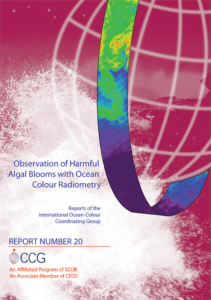 Ocean colour radiometry offers considerable potential for the observation of harmful algal blooms (HABs). Several years ago the IOCCG established a working group on this topic (chaired by Stewart Bernard, SANSA) in conjunction with the GEOHAB international science programme (now GlobalHAB ). We are happy to announce that the report on this topic is in the final stages of publication. The report contains various case studies of remote sensing of harmful algal blooms in coastal and inland waters, including cyanobacterial blooms, toxic diatom and dinoflagellate blooms, fish-killing blooms and other harmful high biomass / ecologically disruptive algal blooms. The advantages and limitations of using satellite ocean colour radiometry for HAB observations are addressed, including the inherent challenges of remote sensing in high biomass, optically complex, coastal and small inland water bodies. The report concludes with chapters on the transition from HAB ocean colour research to operational HAB monitoring systems, as well as future perspectives and recommendations.
Ocean colour radiometry offers considerable potential for the observation of harmful algal blooms (HABs). Several years ago the IOCCG established a working group on this topic (chaired by Stewart Bernard, SANSA) in conjunction with the GEOHAB international science programme (now GlobalHAB ). We are happy to announce that the report on this topic is in the final stages of publication. The report contains various case studies of remote sensing of harmful algal blooms in coastal and inland waters, including cyanobacterial blooms, toxic diatom and dinoflagellate blooms, fish-killing blooms and other harmful high biomass / ecologically disruptive algal blooms. The advantages and limitations of using satellite ocean colour radiometry for HAB observations are addressed, including the inherent challenges of remote sensing in high biomass, optically complex, coastal and small inland water bodies. The report concludes with chapters on the transition from HAB ocean colour research to operational HAB monitoring systems, as well as future perspectives and recommendations.
Once the report has been published (likely within 3-4 months), digital copies will be made available on the IOCCG website at https://ioccg.org/what-we-do/ioccg-publications/ioccg-reports/. Hard copies will also be printed, courtesy of the State Key Laboratory of Satellite Ocean Environment Dynamics, Second Institute of Oceanography, Ministry of Natural Resources, China, which is gratefully acknowledged. If you would like to receive a hardcopy of this report, please complete the IOCCG Report Request Form. A limited number of reports will be printed, so please submit your request in advance (hard copies may not be available at a later date). Also please use a mailing address that will still be valid in several months’ time.
